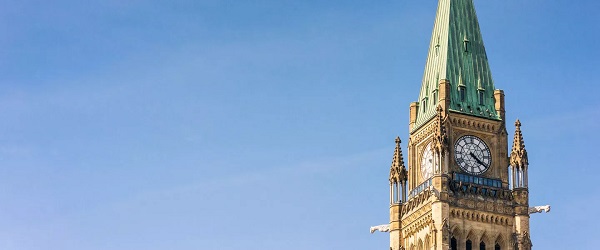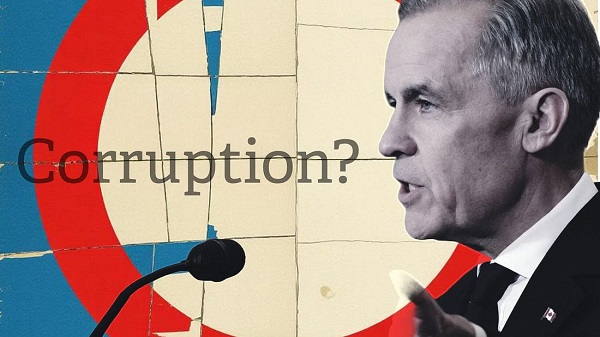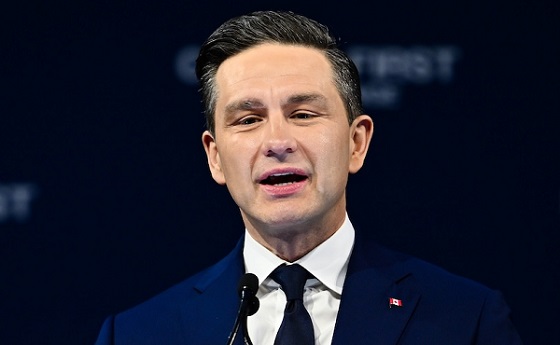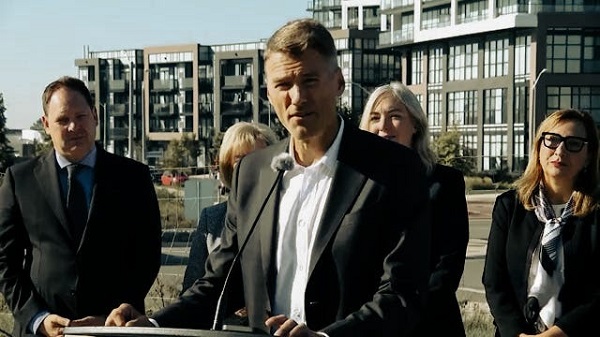Alberta
Mask expert warns Dr. Deena Hinshaw mask use will not protect against COVID-19

Chris Schaefer is the Director of SafeCom Training Services Inc. in Edmonton. He has sent this letter to Dr. Deana Hinshaw. As an open letter it is also being circulated on social medias.
Open Letter to Physicians and the Public of Alberta
Dear Dr. Hinshaw,
Re: Alberta Health recommendation that Albertans wear N95, surgical or non-medical masks in public to reduce the likelihood of transmitting or developing a condition from the coronavirus known as COVID-19
I have been teaching and conducting respirator fit testing for over 20 years and now currently for my company SafeCom Training Services Inc. My clients include many government departments, our military, healthcare providers with Alberta Health Services, educational institutions and private industry. I am a published author and a recognized authority on this subject.
Filter respirator masks, especially N95, surgical and non-medical masks, provide negligible COVID-19 protection for the following reasons:
- Viruses in the fluid envelopes that surround them can be very small, so small in fact that you would need an electron microscope to see them. N95 masks filter 95% of particles with a diameter of 0.3 microns or larger. COVID-19 particles are .08 – .12 microns.
- Viruses don’t just enter us through our mouth and nose, but can also enter through our eyes and even the pores of our skin. The only effective barrier one can wear to protect against virus exposure would be a fully encapsulated hazmat suit with cuffs by ankles taped to boots and cuffs by wrists taped to gloves, while receiving breathing air from a self-contained breathing apparatus (SCBA) This barrier is standard gear to protect against a biohazard (viruses) and would have to be worn in a possible virus hazard environment 24/7 and you wouldn’t be able to remove any part of it even to have a sip of water, eat or use the washroom while in the virus environment. If you did, you would become exposed and would negate all the prior precautions you had taken.
3. Not only are N95, surgical and non-medical masks useless as protection from COVID-19, but in addition, they also create very real risks and possible serious threats to a wearer’s health for the following reasons
A. Wearing these masks increases breathing resistance, making it more difficult to both inhale and exhale. According to our Alberta government regulations on respirator (mask) use, anyone that is required to wear a respirator mask should be screened to determine their ability to safely wear one.
Any covering of the mouth and nose increases breathing resistance, whether the mask is certified or not. Those individuals with pre-existing medical conditions of shortness of breath, lung disease, panic attacks, breathing difficulties, chest pain in exertion, cardiovascular disease, fainting spells, claustrophobia, chronic bronchitis, heart problems, asthma, allergies, diabetes, seizures, high blood pressure and pacemakers need to be pre-screened by a medical professional to be approved to be able to safely wear one. Wearing these masks could cause a medical emergency for anyone with any of these conditions.
Pregnancy-related high blood pressure is possible. More research is necessary to determine the impact of wearing a mask for extended periods of time on pregnancy.
It is dangerous to recommend, much less mandate anyone with medical conditions to wear a mask without educating them about the risks involved in wearing them without having been pre-screened and approved by a medical professional first.
B. In order for any respirator mask to offer protection to a specific user, that user must be individually fitted with the right type, right size, if male – face must be clean shaven (only short moustache allowed). Next, the user must be fit tested with that respirator by a trained professional to determine whether or not the respirator is providing the user with an air- tight seal – a requirement for any respirator mask.
C. N95 masks – N for not resistant to oil particles, 95 for the percentage of protection – the lowest level of all respirator masks.
These masks even when properly sized and fitted will not protect against virus exposure, however they are capable of adequate protection from larger particles such as pet dander, pollen and sawdust.
Surgical masks (the paper ones that loop around the ears) – do not seal to the face and do not filter anything.
Nonmedical and/or homemade masks are dangerous because:
- ● Not engineered for the efficient yet protective requirements of easy inhalation and effective purging of exhaled carbon dioxide
- ● Could cause an oxygen deficiency for the user
- ● Could cause an accumulation of carbon dioxide for the user
- ● Shouldn’t be recommended under any circumstance
D. They increase body temperature and physical stress – could cause a high temperature alert on a thermometer gun
E. They impede verbal communication
F. N95, surgical and nonmedical masks can create infections and possible disease all by themselves by causing exhaled warm, moist air to accumulate on the inside material of the mask, right in front of the user’s mouth and nose, which is the perfect environment for bacteria to form, grow and multiply. That is why N95 and other disposable masks were only designed to be short duration, specific task use and then immediately discarded.
So if masks are not effective in preventing illness, what is? How about the age-old tried, tested and proven method of protecting our health with a healthy diet, clean water, avoidance of processed, junk and fast foods, plenty of fresh air, sunshine, moderate exercise, adequate restful sleep and avoidance of stress?
We all have an immune system that can fight and overcome any COVID-19 threat if it is healthy and we nurture it.
Thank you for reading this open letter and letting me share my expertise. I ask that you share this with the public via media statement as we are all committed to promoting good health for all Albertans. If you or any of the public wish to contact me with a question or comment, I would love to hear from you. I can best be reached [email protected].
Sincerely,
Chris Schaefer
Director
SafeCom Training Services Inc.
Alberta
Diploma Exams Affected: No school Monday as ATA rejects offer of enhanced mediation

Premier Danielle Smith, Minister of Finance Nate Horner, and Minister of Education Demetrios Nicolaides issued the following statement.
“Yesterday, the Provincial Bargaining and Compensation Office wrote to the Alberta Teachers’ Association (ATA) and formally requested an agreement to enter an enhanced mediation process.
“This process would have ensured that students returned to the classrooms on Monday, and that teachers returned to work.
“Negotiating would have continued with the ATA, Teachers’ Employer Bargaining Association (TEBA) and a third-party mediator to propose a recommended agreement.
“We are very disappointed that the Alberta Teachers’ Association refused this offer. Teachers and students should also be disappointed.
“PBCO made this offer to the ATA because the union has not made a reasonable offer and this strike is impacting students. Alberta’s government is trying to put kids first and bring an end to this strike.
“The offer of enhanced mediation provided a clear path to ending it.
“We want the same things as the ATA: More teachers. More pay for teachers. More educational assistants. And more classrooms.
“This strike has gone on too long and we are extremely concerned about the impact it is having on students.
“We are willing to consider further options to ensure that our next generation gets the world-class education they deserve. After about three weeks, a strike of this nature would reach the threshold of causing irreparable harm to our students’ education.
“The ATA needs to do what is right for its members, and for all Alberta students.
“If it refuses to do so, we will consider further options to bring this strike to an end.”
Diploma exam update
November diploma exams will be optional for students.
With instructional time in schools disrupted due to the teacher strike, the November 2025 diploma exams will now be optional for students. Students who wish to write a diploma exam may request to do so, and their school boards will accommodate the request.
The optional diploma exams apply to all schools provincewide. These exams will still take place on the currently scheduled dates.
Students who choose not to write the November diploma exams can still complete their courses and graduate on time. Their final grade will be based entirely on the school-awarded mark provided by their teacher.
Choosing not to write the November diploma exams will not affect a student’s ability to apply to, be accepted by, or attend post-secondary institutions after graduation.
No changes have been made to the January and June diplomas and provincial achievement tests.
Quick facts
- Students are automatically exempted from writing the November diploma exams but can request to write them.
- School boards must allow the student to write the diploma exam if requested.
Alberta
Alberta taxpayers should know how much their municipal governments spend

From the Fraser Institute
By Tegan Hill and Austin Thompson
Next week, voters across Alberta will go to the polls to elect their local governments. Of course, while the issues vary depending on the city, town or district, all municipal governments spend taxpayer money.
And according to a recent study, Grande Prairie County and Red Deer County were among Alberta’s highest-spending municipalities (on a per-person basis) in 2023 (the latest year of comparable data). Kara Westerlund, president of the Rural Municipalities of Alberta, said that’s no surprise—arguing that it’s expensive to serve a small number of residents spread over large areas.
That challenge is real. In rural areas, fewer people share the cost of roads, parks and emergency services. But high spending isn’t inevitable. Some rural municipalities managed to spend far less, demonstrating that local choices about what services to provide, and how to deliver them, matter.
Consider the contrast in spending levels among rural counties. In 2023, Grande Prairie County and Red Deer County spent $5,413 and $4,619 per person, respectively. Foothills County, by comparison, spent just $2,570 per person. All three counties have relatively low population densities (fewer than seven residents per square kilometre) yet their per-person spending varies widely. (In case you’re wondering, Calgary spent $3,144 and Edmonton spent $3,241.)
Some of that variation reflects differences in the cost of similar services. For example, all three counties provide fire protection but in 2023 this service cost $56.95 per person in Grande Prairie County, $38.51 in Red Deer County and $10.32 in Foothills County. Other spending differences reflect not just how much is spent, but whether a service is offered at all. For instance, in 2023 Grande Prairie County recorded $46,283 in daycare spending, while Red Deer County and Foothills County had none.
Put simply, population density alone simply doesn’t explain why some municipalities spend more than others. Much depends on the choices municipal governments make and how efficiently they deliver services.
Westerlund also dismissed comparisons showing that some counties spend more per person than nearby towns and cities, calling them “apples to oranges.” It’s true that rural municipalities and cities differ—but that doesn’t make comparisons meaningless. After all, whether apples are a good deal depends on the price of other fruit, and a savvy shopper might switch to oranges if they offer better value. In the same way, comparing municipal spending—across all types of communities—helps Albertans judge whether they get good value for their tax dollars.
Every municipality offers a different mix of services and those choices come with different price tags. Consider three nearby municipalities: in 2023, Rockyview County spent $3,419 per person, Calgary spent $3,144 and Airdrie spent $2,187. These differences reflect real trade-offs in the scope, quality and cost of local services. Albertans should decide for themselves which mix of local services best suits their needs—but they can’t do that without clear data on what those services actually cost.
A big municipal tax bill isn’t an inevitable consequence of rural living. How much gets spent in each Alberta municipality depends greatly on the choices made by the mayors, reeves and councillors Albertans will elect next week. And for Albertans to determine whether or not they get good value for their local tax dollars, they must know how much their municipality is spending.
-

 Business2 days ago
Business2 days agoFederal Budget 2025: A responsible media would ensure Canadians know about the dismal state of federal finance
-

 Business2 days ago
Business2 days agoCanada has an energy edge, why won’t Ottawa use it?
-

 International1 day ago
International1 day agoPoland’s president signs new zero income tax law for parents with two children
-

 Automotive15 hours ago
Automotive15 hours ago$15 Billion, Zero Assurances: Stellantis Abandons Brampton as Trudeau-Era Green Deal Collapses
-

 Alberta2 days ago
Alberta2 days agoDiploma Exams Affected: No school Monday as ATA rejects offer of enhanced mediation
-

 Business2 days ago
Business2 days agoEthics on Ice: See You Next Year
-

 International1 day ago
International1 day agoAustralian territory bans men from women’s prisons in national first
-

 National1 day ago
National1 day agoPoilievre accuses Canada’s top police force of ‘covering up’ alleged Trudeau crimes





